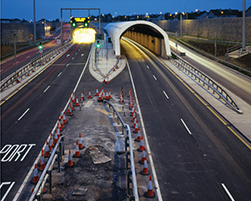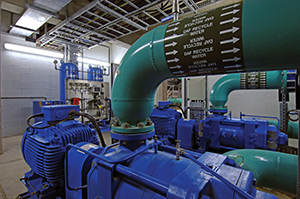Assessing Ireland’s infrastructure
The Engineers Ireland 2015 review of infrastructure looks at the state of Ireland’s key infrastructure networks and grades them accordingly.
Proper infrastructure is essential for any nation’s competitiveness and success. Engineers Ireland’s ‘State of Ireland’ report focuses on the performance, capability and condition of Ireland’s key infrastructure networks. The report is intended to inform those who make investment decisions about infrastructure in Ireland including public servants and private investors with the aim of recommending actions vital to Ireland’s future prosperity.
Aside from its economic importance, infrastructure is the cornerstone of modern society and this dependence will continue to increase in the coming decades.
To help explain its assessment of the quality of Irish infrastructure Engineers Ireland has included a straightforward grading system from A-E. The definition of these grades are:
Well maintained, in good condition with appropriate capacity and planning for future development;
Acceptable standard, properly maintained, and able to meet demand though investment will be needed in the next five years;
Inadequately maintained and/or unable to meet peak demand and requiring significant investment;
Below standard, poorly maintained, frequent inability to meet capacity and requiring immediate investment to avoid adverse impact on the national economy;
Unacceptable condition, insufficient capacity and already impacting on the national economy.
Transport
 Developing a transport infrastructure which meets the requirements of Irish society and the Irish economy is essential to the future prosperity of the State. Critical to this is an integrated approach to road, rail, air and sea transport.
Developing a transport infrastructure which meets the requirements of Irish society and the Irish economy is essential to the future prosperity of the State. Critical to this is an integrated approach to road, rail, air and sea transport.
Throughout 2015 Ireland’s road network saw a steady rise in general traffic volumes which saw a return of severe traffic congestion at peak times. Ireland has a radial motorway network extending out of Dublin that is on par with those in Europe. Investment in roads has been targeted at upgrading roads where there is the highest demand and this has resulted in Ireland’s motorways being able to meet demand, apart from the M50 which is currently carrying 29 per cent more traffic since its upgrade in 2010.
However, with motorways invariably linked to Dublin this means that links between regional cities are much less impressive. The report highlights the Cork to Limerick road as one that is of particularly poor quality and states that significant investment is needed in terms of connecting Galway, Cork, Limerick and Waterford to each other.
Engineers Ireland accepts that the funding available to operate, maintain and improve the national road network has been significantly reduced in recent years. However, Ireland’s remaining road network is in very variable condition, with a lot of traffic congestion in cities and towns at peak periods.
The quality of these networks has been allowed to deteriorate and repairs have only been carried out on a patchwork basis with roads that were repaired in the 1990s and early 2000s now due for maintenance again. Ireland’s road system needs to be improved, but this will have to be advanced in the context of prioritisation.
Turning its attention to Ireland’s rail network, the report states that in 2015 the Luas BXD project is the only major piece of transport infrastructure currently in development. This project is intended to reduce the problem of connectivity in both light and heavy rail. Looking at the potential for future developments to achieve the desired modal shift further investment will be required and the extension of DART service to Dublin Airport will need to be accelerated.
As Ireland is an open economy with substantial inward investment, international air connectivity is critical for tourism and business travel. At present, Irish airports and air traffic control systems are well maintained. Dublin Airport Authority’s desire to develop a second runway is noted but the report states that whilst such investment will be essential in the future, it is not an immediate requirement.
In the short to medium term, Engineers Ireland has called for continued investment in the maintenance of airports and the assets that support economic recovery. Looking further ahead, it will be important to maintain smaller regional airports because of their importance for the economic development of Ireland outside Dublin.
Ireland’s commercial sea ports are vital for most exports and imports, as well as for the tourism sector. The commercial ports are generally well maintained while the same can be said for smaller harbours like Cill Rónáin Harbour on Inis Mór. However, changing market conditions are driving the need to invest in new port infrastructure.
As ports are large it can take many years from planning to delivery and Engineers Ireland has called for further development of commercial ports to facilitate larger vessels that can deliver economies of scale and improve overall national competitiveness. To achieve this a streamlining of the statutory planning process is required to ensure that infrastructure can be delivered in an integrated and timely fashion.
Waste
Waste management infrastructure is in a period of transition across Ireland. Historical treatment facilities are being replaced by more advanced and environmentally preferred solutions. The latest statistics from the Environmental Protection Agency are from 2012. The figures show that there are 25 landfill sites in the country compared to 87 in 1995. The number of landfill  sites accepting municipal waste for disposal is continuing to decrease. This reduction in landfill sites is resulting in the inter-regional movement of waste.
sites accepting municipal waste for disposal is continuing to decrease. This reduction in landfill sites is resulting in the inter-regional movement of waste.
Despite a growth in the number of people living in Ireland, since its peak in 2007 municipal solid waste generation has dropped by 23 per cent. The recycling rate for municipal waste is 45 per cent, higher than the EU27 average of 40 per cent. There are now 45 composting facilities with 386,100 tonnes of operating capacity. The most recent figures show that composting of biodegradable waste increased by 44 per cent compared to the previous year and in 2012 incineration to energy recovery increased by 114 per cent.
Recent trends suggest that municipal wastes and other major streams such as construction and demolition wastes have dropped in Ireland as a direct consequence of the economic downturn. Future streams of waste are intrinsically linked to the performance of the economy and its ability to move out of recession. The State has immediate targets to reach under the EU Landfill Directive, which require it to reduce the quantity of biodegradable municipal waste consigned to landfill and while the targets for 2010 and 2013 have been met, targets set for this year will be more difficult to achieve.
The national waste policy statement reinforces the State’s commitment to ending the practice of disposal to landfill. This policy, along with the State’s ambition to be self-sufficient in terms of treatment capacity will drive the infrastructure agenda in this sector.
Looking ahead, the report is critical of the delays to the Poolbeg incinerator in Dublin and the similar fate of the Cork incinerator stating that as a result of this delay there has been no significant investment in landfills for a number of years. With the waste equation currently being balanced by reduced consumerism and the export of black bin waste, should the economy show signs of recovery waste levels will rise and the gap between the capacity to manage and volume will grow.
To close this gap investment in infrastructure is vital. At present there is high capacity levels of pre-treatment and mechanical treatment but below capacity levels of final destination facilities. To improve this situation the State needs to develop a new waste management plan to drive the development of appropriate treatment capacities. Similarly, this changing landscape will need to be tackled in the future education of science and engineering undergraduates.
The report also looks at Ireland’s flood provisions and warns that many areas remain in danger of flooding and risks in areas not currently associated with flooding will increase. The Office of Public Works (OPW) continues to advance major capital flood relief schemes and minor flood works, in partnership with local authorities, to protect against fluvial costal/tidal and groundwater flooding.
Despite this, the lack of river defences in some towns, combined with poorly maintained river channels are an issue. The maintenance of channels that fall outside the OPW’s area of responsibility is more ad hoc and maintenance programmes that are not part of an arterial drainage scheme were never particularly well structured.
Ireland’s capability to plan and implement a maintenance regime to manage flooding remains poor and the curtailment of maintenance regimes to save money in the short terms incurs larger costs in the longer term. Across the country, Flood Risk Management Plans will be central to a proactive approach for managing existing and potential future flood risks. The report warns that failure to resolve the flooding issue will create further economic challenges.
Water

Water is a vital resource that many developed nations take for granted. The abundance of water in Ireland is one the country’s many natural advantages but the management of this resource to satisfy all stakeholders is critical for its continued success.
In compiling this report Engineers Ireland looked at the water networks; water in the natural environment and flood management. Raw water is taken from the natural environment and then treated, stored and distributed through pipes into people’s homes. The quality of water is paramount to the health of Ireland’s citizens and its overseas visitors. Since January 2014, Irish Water has been responsible for Ireland’s water supply and wastewater assets.
The latest report from the Environment Protection Agency published in 2015 assessed drinking water quality in 2013 and found that the quality of water available to different communities varied widely. Addressing this variation will be the biggest challenge for the single utility provider. The Environmental Protection Agency was also critical of Ireland’s wastewater treatment plants as 30 per cent of them did not meet all EU effluent quality and sampling standards. The infrastructure for wastewater collection is also of variable quality across the country.
Looking to the future, it is of paramount importance that the regulator ensures the pricing model for water is both acceptable to the consumer and adequate to fund the investment that is required to improve the network. The report also encourages further incentives to encourage conservation and the introduction of variables charges for water usage. With regards to wastewater, secondary treatment facilities should be established in urban areas and inspections, monitoring and enforcement of authorisations are crucial to the continued effectiveness of Ireland’s wastewater treatment plans.
Communications
 Ireland’s communication network is responsible for saving lives, assisting in business decisions and providing citizens and tourists with entertainment options. From critical contact among emergency services, to the transfer of big data from devices and the method by which a large segment of the population access their leisure activities the nation’s dependency on voice and data transmission infrastructure is the greatest it has ever been.
Ireland’s communication network is responsible for saving lives, assisting in business decisions and providing citizens and tourists with entertainment options. From critical contact among emergency services, to the transfer of big data from devices and the method by which a large segment of the population access their leisure activities the nation’s dependency on voice and data transmission infrastructure is the greatest it has ever been.
Throughout 2014 the roll-out of the 4G network by Ireland’s mobile providers was continuing although coverage was limited by networks to specific urban areas. In 2014, 9 per cent of mobile users accessed the 4G network and data volumes continued to rise. The growth in adoption of broadband with speeds above 30Mbps has more than doubled since 2012. This rise is credited to the introduction of fibre broadband and the increase in subscriptions likely attributable to services being offered as bundles.
Comparing the price of pre-paid mobile and bill pay packages, the OECD ranks Ireland cheaper than the UK and four other OECD countries and the second cheapest for bill pay. However when it comes to business packages Ireland is ranked last out of six comparable OECD countries, with the average price 38 per cent higher than the other countries analysed.
The cost and quality of broadband access is fundamental to the economic success of enterprises that need connectivity for their businesses. The cost of broadband access is coming down, however the disparity of speeds available is increasing between rural and urban areas and prices do not reflect this. However, thanks to the national broadband plan and the continued roll-out of fibre networks Ireland’s broadband infrastructure is constantly being reinforced.Further investment in major network upgrades to cater for the higher speeds will be required in the future. Similarly, with the increasing importance of cloud computing applications hosted in data centres the Government needs to prioritise connecting Ireland’s network to international cities to compete with global business.
While Ireland’s communications infrastructure is of an acceptable standard at present it is clear that in all areas development is needed to ensure Ireland has the appropriate capacity to meet future demand.





